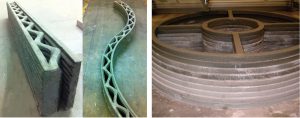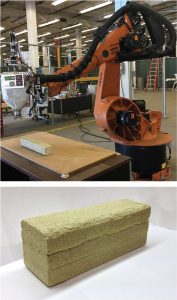3-D Printed Concrete Walls
Advances in construction technology create opportunities using new and innovative methods for the building construction industry, which are fast, efficient, reliable, and cost-effective. One of these methods is three-dimensional (3-D) printing construction technology (also known as additive manufacturing) for the job site construction of 3-D concrete structures. Although 3-D printing technology is not new and has been utilized for small-scale part production since the 1980s, it has found its way most recently into the construction industry and is pushing the boundaries of how engineers view and approach building construction.
Construction with 3-D printing technology offers many advantages, including reduction of costs through its single-step construction process by decreasing labor and eliminating the need for concrete forms, reducing construction times, providing affordable dwellings for people in urgent need of shelter, and greener construction by utilizing materials more efficiently and creating less waste. It also provides improved and rapid project planning, reduction of accidents as a result of a reduction in labor, new design possibilities, freedom to create complex designs, and many more advantages. In a research study (Lofgren, 2005), it was shown that formwork typically accounts for 40 to 60 percent of the total construction costs; therefore, formwork elimination by 3-D printing may lead to considerable financial savings. Because of these advantages and the high demand for affordable housing in the United States and other countries, many major city jurisdictions are considering the ability of 3-D printing construction technology to help solve the homelessness crisis.
In the U.S., a system of model building codes is adopted by local jurisdictions who have the authority to enforce construction regulations. The International Building Code (IBC) Section 104.11 allows for the integration of new construction products, systems, and technologies not explicitly described in the code itself, permitting manufacturers to demonstrate that these products are compliant with the intent of the code. This evaluation is typically accomplished through product testing following established and peer-reviewed acceptance criteria documents. Acceptance criteria documents outline specific product sampling, testing, and quality requirements that must be fulfilled to verify a product is code-compliant. The results of evaluation and testing are summarized in a research report made available to code officials.
As of 2020, there are no provisions for 3-D printing construction technology within the IBC. Therefore, an acceptance criteria document for 3-D concrete walls (AC509) has been developed under IBC Section 104.11 by the ICC Evaluation Service. It states that supporting data, where necessary to assist in the approval of materials or assemblies not expressly provided for in the code, can consist of accurate research reports from approved sources to demonstrate building code compliance verification. The new AC509 addresses wall construction using 3-D printing, evaluating structural strength, fire safety, and material durability. AC509 also outlines specific product sampling and quality requirements that must be fulfilled to obtain code compliance verification.
Background
One of the innovations in 3-D printing technology is the use of Contour Crafting building printing technology, which was developed at the University of Southern California (USC) in 1997. Contour Crafting building printing is a new layered 3-D printing technology that enables the automated construction of entire structures. Contour Crafting uses computer control to exploit the superior surface-forming building printing technology capability of troweling to create smooth and accurate planar and freeform surfaces. Some building elements built using Contour Crafting technology are shown in Figure 1.
There has been a significant number of projects that have used Counter Crafting technology since 1997. However, most of these projects used either mortar or clay as the 3-D printing material. While clay seems a viable option for non-structural purposes, its mechanical properties may not be as suitable as concrete for building construction. The main advantage of using concrete is that it is the most widely used construction material in the world.
Other than building construction, infrastructure development and planetary construction are two other areas that have been explored regarding the advancement of 3-D printed construction. Different infrastructure elements may be automatically built with variations of the Contour Crafting technology. For example, in a research project (Khoshnevis et al., 2016), sulfur concrete was used as the material for planetary construction purposes. In this process, sulfur was pre-melted and then mixed with other ingredients (elemental sulfur, sulfur modifier, coarse aggregate, and fine aggregate) at 150°C, and was kept in the reservoir for one hour until the elemental sulfur was modified. The enhanced articulated robot used in this project, as well as a successfully extruded multi-layer sample (made with sulfur concrete), are shown in Figure 2.
Acceptance Criteria Test Methods
The following definitions were developed to be used within AC509:
- 3-D Automated Construction Technology: Construction-scale 3-D printing technology, also known as additive manufacturing or layer-by-layer automated construction technology.
- 3-D Concrete: A proprietary cementitious material that consists of cement, fibers, and supplementary cementitious materials (if applicable), fine and/or coarse aggregate, and admixtures (if applicable).
- 3-D Concrete Walls: Walls that are constructed with the use of 3-D printing construction technology by printing 3-D concrete in layers to create two outer face shells, and then placing a proprietary concrete core between the shells to form a solid wall. If applicable, structural steel reinforcing can be placed within the proprietary concrete core.
- 3-D Printer and Software: Computer-controlled equipment, which includes a frame and rail system used to support and control the position and orientation of a proprietary nozzle, used to construct 3-D concrete walls. The 3-D printer software is the computer program used to control the 3-D concrete flow and nozzle speed, position, and orientation.
- Proprietary Concrete Core: Self-consolidating proprietary concrete poured in place between the 3-D printed outer face shells. The proprietary concrete core is either the same as, or a different mixture than, the 3-D concrete mixture.
Material Tests
To qualify under Section 104.11 of IBC, Acceptance Criteria, AC509 requires the following material tests:
- Concrete compressive strength testing in accordance with ASTM C39 or ASTM C109 with minimum average 28-day compressive strength of 2500 psi (17.2 MPa).
- Concrete slump testing in accordance with ASTM C143 or ASTM C1611, to be reported for quality control purposes.
- Freezing and thawing durability testing of both outer face shells and core concrete in accordance with Procedure A of ASTM C666 for a minimum of 300 cycles and minimum durability factor of 80.
- Shrinkage and volume change testing in accordance with ASTM C157 with the acceptance conditions of 0.064 percent or 0.050 percent depending on aggregate size and fiber used.
- Because the presence of discontinuous fibers in a 3-D concrete mixture may affect the performance of 3-D constructed concrete walls, AC509 requires that fibers used in 3-D concrete mix design comply with a consensus acceptance criterion for quality control.
- Test for minimum and maximum extrusion time intervals. The performance of a 3-D concrete wall may be affected by the time interval between the extrusion of concrete from the printer nozzle for each layer. Therefore, AC509 developed a procedure using Section 5.2 (Method A) of ASTM E518 to understand the effect of minimum and maximum time intervals between extrusion of 3-D concrete layers on the bond between the extrusion layers.
Structural Performance Tests
AC509 requires full-scale structural tests for each 3-D concrete wall configuration, with or without structural steel reinforcement, and for each combination of 3-D concrete mixture design to be tested to justify the design provisions. AC509 requires the following details to be considered while preparing test plan: each 3-D concrete mixture design, reinforcing details (rebar size and spacing), variation in geometry of the 3-D concrete outer shells (such as thickness and width of the extrusion layers) and the proprietary concrete core, and minimum and maximum time intervals between extrusion layers. Wall axial compression tests, wall flexure tests, and wall static in-plane shear tests are required for the justification of structural design provisions.
AC509 also requires that a design criteria report is submitted by a registered or licensed design professional, which must include complete analysis and interpretation of the qualification test results demonstrating that 3-D concrete walls can be designed in accordance with the applicable sections of the IBC. Test data must qualify the design characteristic strengths used in the analysis and design. Any deviation from design must be established in the analysis for inclusion in the final research report. Average maximum strength is to be reduced by a factor of 3 to determine characteristic strengths and must be used to verify or modify the design equations in applicable codes. Also, per AC509, where loading conditions result in combined transverse and axial loads, the sum of the ratios of actual loads over design loads must not exceed one.
Other Compliance Requirements
The following requirements and limitations are included in AC509. Once more research is available, these limitations may be revised.
- The 3-D concrete walls are limited to use in one story single-unit residential dwellings.
- The 3-D concrete walls are limited to non-fire resistance-rated construction unless qualified by testing in accordance with ASTM E119.
- The 3-D concrete walls used as the lateral-force resisting system are limited to Seismic Design Categories (SDC) A and B only.
- The foundation and roof, and their anchorage to the 3-D concrete walls, must comply with applicable sections of the IBC.
- The structural calculations must address the design and detailing of openings and loads on headers.
- Exterior envelope requirements of the applicable codes have not been evaluated and are outside the scope of this article.
Conclusions
The IBC is the predominant building code in the U.S. IBC Section 104.11 allows for alternative materials, design, and methods provided that such alternatives are evaluated to meet the intent of code requirements. Acceptance criteria document AC509 provides the required evaluation criteria and data for quantifying the performance characteristics of 3-D concrete walls constructed using 3-D printing construction technology to satisfy the intent of the building code. The resulting final research (evaluation) report issued per AC509 is intended to demonstrate code compliance and is primarily used by code officials and structural engineers.■
References
- AC509, Acceptance Criteria for 3-D Automated Construction Technology for 3-D Concrete Walls. ICC Evaluation Service, June 2019, www.icc-es.org.
- EL Studio, [Online]. Available: http://elstudioarch.com. [Accessed 01 02 2016].
- B. Khoshnevis, X. Yuan, B. Zahiri, J. Zhang, and B. Xia, “Construction by Contour Crafting using sulfur concrete with planetary applications,” Rapid Prototyping Journal, Vol. 22, No. 5, pp. 848-856, 2016.
- I. Lofgren, Fibre-reinforced Concrete for Industrial Construction, Ph.D. Thesis, Chalmers University of Technology, 2005
- B. Khoshnevis, “Contour Crafting: A New Rapid Prototyping Process,” Proceedings of the 7th International Conference on Rapid Prototyping, pp. 13-22. 1997.


